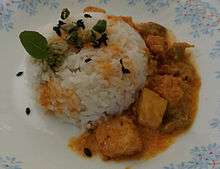Chaunk

Chaunk (Hindi: छौंक); sometimes spelled chhaunk, chounk, chonk, chhounk, or chhonk; also called তড়কা (torka), বাগার (bagar), ফোড়ন (phoron) in Bengali, Tarka (ਤੜਕਾ) in Punjabi, Thaalithal (தாளித்தல்) in Tamil, oggaraṇe (ಒಗ್ಗರಣೆ) in Kannada,फोण्ण in Konkani, vaghaar (વઘાર) in Gujarati, fodni (फोडणी) in Marathi, Thalimpu (తాళింపు) or popu ( పోపు in Telugu), Baghaar (Urdu: بگھار) ; Baghaara (ବଘାର) or Chhunka (ଛୁଙ୍କ) in Oriya, often translated as "tempering", is a cooking technique and garnish used in the cuisines of India, Bangladesh, and Pakistan, in which whole spices (and sometimes also other ingredients such as minced ginger root or sugar) are fried briefly in oil or ghee to liberate essential oils from cells and thus enhance their flavours, before being poured, together with the oil, into a dish.
Chaunk may be prepared at the beginning of cooking, before adding the other ingredients for a curry or similar dish, or it may be added to a dish at the end of cooking, just before serving (as with a dal, sambar or stew).
Ingredients used

Ingredients typically used for chaunk include cumin seeds, black mustard seeds, fennel seeds, fresh green chilis, dried red chilis, fenugreek seeds, asafoetida, cassia, cloves, urad dal, curry leaves, chopped onion, garlic, or tejpat leaves. When using multiple ingredients for a chaunk they are often added in succession, with those requiring longer cooking added earlier, and those requiring less cooking added later. In Oriya cuisine and Bengali cuisine, a mixture of whole spices called Panch phutana or panch phoron is used for this purpose.
Etymology
The Hindi name, chhaunk (the initial consonant, "chh" [छ], is a heavily aspirated "ch" sound), is believed to be onomatopoetic, imitating the muffled sound of the just-fried spices being added to a dal or other dish.

The Bengali name, bagar dewa (বাগার দেয়া), translates as "to temper" (bagar = the act of tempering; dewa = to give; hence "to give temperance to").